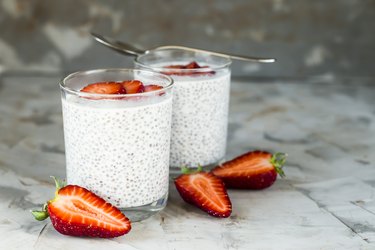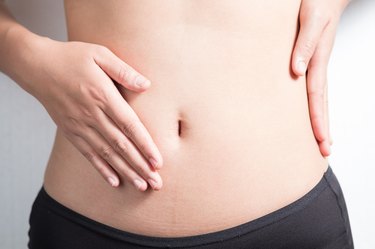
For years, low-carb diets have been used to fuel weight-loss efforts, and the Atkins diet may be the most popular. It's a four-phase plan that limits carbohydrates and emphasizes protein and fats.
The objective of the diet, according to the Atkins website, is to change your eating habits to promote weight loss and a healthier lifestyle. Since its start, the brand has expanded to three different programs (Atkins 20, Atkins 40 and Atkins 100) to choose from.
Video of the Day
Video of the Day
The first phase of the Atkins 20 diet (the "classic" Atkins diet), called the induction phase, has a particular set of guidelines meant to help kickstart your weight loss.
Here's all you need to know about the Atkins induction phase and its rules, the foods to eat and avoid and the risks to watch out for.
First, How Does the Atkins Diet Work?
The Atkins 20 diet consists of four phases. Here's a quick look at what they entail, according to the Atkins website:
- Phase 1 (Induction): You'll eat 20 to 25 grams of daily net carbs. This is the most restrictive phase, as you're not allowed to eat legumes, whole grains, or certain fruits and vegetables.
- Phase 2 (Balancing): You'll eat 25 to 50 grams of daily net carbs, slowly adding more foods to your diet but still restricting whole grains and some fruits and veggies.
- Phase 3 (Pre-maintenance): You'll aim for 50 to 80 grams of net carbs daily, with no foods restricted.
- Phase 4 (Lifetime maintenance): You'll aim for 80 to 100 grams of net carbs daily, with no foods restricted.
Overall, the diet is meant to adjust your balance of fats, carbs and protein so your body will primarily use fat as its source of energy instead of carbs, which spurs weight loss, according to the website.
How Many Calories Do You Eat on the Atkins Diet?
Even though net carbs, not calories, are counted on the Atkins Diet, calories still do matter. Adults can expect to eat anywhere from 1,500 to 2,000 calories per day on the diet.
What Is the Induction Phase of the Atkins Diet?
Induction is the first phase of the low-carb, high-protein Atkins diet. It helps kickstart weight loss by limiting the amount of net carbs you eat. Net carbs (i.e., the only carbs counted on the Atkins plan) are calculated by subtracting the fiber and sugar alcohol content of a food from its total carb content.
Phase one of Atkins lasts two weeks, or can be followed until you've lost within 15 pounds of your goal weight, per the Atkins website. How much weight you'll lose and how quickly will depend on different factors like your body size and composition, metabolism, genetics and underlying health issues.
What Happens During the Induction Phase?
The induction phase sets you up for the rest of the program. Here's what you can expect:
1. You Eat 20 to 25 Grams of Net Carbs per Day
During induction, you're encouraged to keep your net carbs very low, between 20 and 25 grams per day. Twelve to 15 grams of these daily carbs should come from nonstarchy vegetables like broccoli and cucumbers, and the rest may come from dairy, dressings or Atkins products.
To put this into perspective, the National Academies of Science, Engineering and Medicine recommends the average adult get 130 grams of carbohydrates per day.
Ultimately, you're eating way less carbohydrates than the recommended daily amount (RDA) during the induction phase.
Tip
Atkins has a free weight loss calculator and carb counter app that you can use to track your progress.
2. Your Body Uses Fat for Energy
When your body only gets about 20 grams of net carbs per day, it's forced to use your fat stores for energy (also called ketones), in replacement of glucose. This phenomenon is known as ketosis, per the Cleveland Clinic.
In short, this is how weight loss on Atkins occurs: You end up losing body fat because your body begins to rely on fat cells for energy instead of carbohydrates.
3. You Maintain Stable Blood Sugar Levels
Eating a low-carb diet filled with fruits and vegetables can help prevent blood sugar spikes, per Harvard Health Publishing.
When your body has a blood sugar spike, it causes an overproduction of insulin, which causes carbohydrates to turn into body fat.
4. You May Lose Weight
You could lose a significant amount of weight during the induction phase because your diet is so restricted, but the exact amount will vary from person to person, per the Mayo Clinic.
Atkins weight-loss results after one month, for example, will vary depending on your body size, metabolism, genetics and other health factors.
Keep in mind, most of the weight you initially lose could be water weight instead of body fat. And if you're not losing weight on a low-carb diet, it could be due to other factors, such as stress, metabolism or an underlying health issue.
What Foods Are Allowed During Induction?
There are a few food groups you should aim to include each day while in the induction phase of the Atkins diet. These include protein, fats and nonstarchy vegetables. The Atkins induction food list includes the following, per the Atkins website:
- Chicken
- Poultry
- Beef
- Shellfish
- Pork
- Veal
- Eggs
- Vegetable proteins
- Olive oil and canola oil
- Butter
- Salad greens
- Nonstarchy vegetables like broccoli, green beans, asparagus, celery and peppers
- 10 to 20 olives
- Up to 4 ounces of hard or aged cheese
- Half an avocado
- An ounce of sour cream
- 2 to 3 tablespoons of unsweetened cream in coffee or tea
- Up to 3 tablespoons of lemon or lime juice
- 1 to 2 servings of Atkins diet foods (prepackaged bars or shakes with 3 grams or less of net carbs, which you can purchase from the Atkins online store or in some grocery stores)
Up to three packets of artificial sweeteners are allowed per day, including sucralose, saccharin and stevia. Diet beverages and sugar-free gelatin that contain these sweeteners are also OK.
You can create your own Atkins Diet meal plan to help you get started, or find one online.
Can Vegetarians Do the Atkins Diet?
Yes. Vegetarians would omit the meat from the food list above and find sources of protein and fat from things like tofu, soy products, eggs, nuts and dairy products. While it may be a little more difficult to get all the protein and fat per day without eating meat, it is possible, per the Atkins website.
If you're unsure how to follow the Atkins diet while maintaining a vegetarian lifestyle, talk to a registered dietitian or doctor who can offer some options.
Tip
There are also gluten-free products, like shakes and bars, sold by Atkins if you have dietary restrictions that require you to eat gluten-free foods.
Foods to Avoid During the Induction Phase
There are a few specific foods you should avoid while in the induction phase of the Atkins diet. These include the following, per the Atkins website:
- Processed and natural sugar
- Starchy vegetables (potatoes, yams, corn and winter squash)
- Bread
- Pasta
- Whole grains like brown rice, oats, quinoa and farro
- Trans fats (hydrogenated or partially hydrogenated vegetable oils)
- Whole-milk dairy
- Fruit
- Nuts, seeds and their butters
- Any food that is a combination of protein and carbs (lentils, chickpeas, kidney beans or other legumes)
Alcoholic beverages should also be avoided during the induction phase.
Other Guidelines for the Induction Phase
Some other guidelines that can help you stay on track during the induction phase of the Atkins diet include the following, per the Atkins website:
- Eat regularly, going no more than six hours during the day without a meal or snack
- Aim for 20 to 25 grams of net carbohydrates daily
- Make sure to get 12 to 15 grams of net carbohydrates from low-carb vegetables
- Eat 4 to 6 ounces of protein at each meal
- Get 11.5 to 15.5 cups of water daily, through drinking and water-rich foods
If you are unsure about what to eat on the Atkins diet, there are Atkins meal kits that you can purchase, which include shopping lists and ingredients required for specific meals.
Should You Exercise During the Induction Phase?
According to the Atkins website, exercise during induction isn't necessary, and you can lose weight without physical activity. However, it also notes that it's a good idea to exercise for other reasons.
In fact, the CDC recommends getting at least 150 minutes of moderate-intensity exercise per week, for benefits like improved heart health and circulation, muscle tone, bone strength and improved mental health.
Risks of the Atkins Diet
Like other diet programs, especially ones that are low-carb, the Atkins diet doesn't come without risks. Some side effects you may experience at the beginning of the induction phase include the following, per the Mayo Clinic:
- Headache
- Dizziness
- Weakness
- Fatigue
- Nausea
- Bad breath
- Confusion
Some risks to keep in mind during the induction phase include:
1. Rapid Weight Loss
While it may feel tempting to lose weight really quickly, it isn't the healthiest approach.
In fact, the National Institutes of Diabetes and Digestive and Kidney Diseases (NIDDK) says a good weight-loss program promotes a slow and steady rate of weight loss of 1 to 2 pounds per week.
Rapid weight loss is not sustainable or a permanent form of weight-loss control, which Atkins claims can be found by going through all four phases of the program. (Note: You could also learn this by talking to a registered dietitian about your specific needs.)
With that said, if you find the induction phase too restrictive or extreme for your goals, you can skip it altogether and begin phase two (called the balancing phase).
2. Harmful Health Effects From Ketosis
As your body begins to rely on fat stores for energy rather than carbohydrates, you may enter a state called ketosis, per the Cleveland Clinic.
While this is helpful for some people (like those who manage epilepsy and seizures), it is not healthy or sustainable to stay in ketosis long-term without a doctor's approval and supervision.
The keto diet in particular (which is not the Atkins diet, but can produce similar effects in the body) can cause side effects like low blood pressure, kidney stones, constipation, nutrient deficiencies and an increased risk of heart disease, per the University of Chicago Medicine.
3. Low Blood Sugar
Without natural sugar from fruits and certain starchy vegetables, you may experience a dip in blood sugar levels that is unhealthy. Because the induction phase of the Atkins diet does not allow for too many added sugars, you may experience dizziness, weakness and shaking from low blood sugar, per the Cleveland Clinic.
4. Nutrient Deficiencies
Some low-carb diets may cause you to restrict fruits and certain vegetables, which contain high amounts of vitamins and minerals. Without them, you could experience vitamin and fiber deficiencies, which could cause weakness, constipation and nausea, per the Mayo Clinic.
5. Constipation
In the induction phase, you'll typically eat fewer high-fiber foods such as fruit, vegetables and whole grains. This could lead to a backup in your bowel movements, i.e., constipation, per the Cleveland Clinic.
In fact, you may need to take a fiber supplement in order to stay regular while starting out the diet.
6. Diarrhea
While constipation is a common problem for people in the induction phase of the Atkins diet, you may also experience diarrhea, per the Cleveland Clinic. This can be due to the higher fat intake that the phase requires — in the form of cheese and cream. You may also experience diarrhea from Atkins bars, shakes or other products the company sells.
To treat diarrhea while on Atkins induction, you may want to eliminate any forms of dairy to see if things get better, and try a fiber supplement specifically designed to relieve diarrhea. You should also stay hydrated by drinking plenty of water.
Other than that, your body may just need time to adjust to the varying levels of fat and carbohydrates you consume during this time.
5. Disordered Eating
Restrictive diets like low-carb diets can cause some people to develop unwanted thoughts and behaviors surrounding food, diet and body image. In fact, one August 2022 study in Eating and Weight Disorders — Studies on Anorexia, Bulimia and Obesity found that those who follow low-carb diets are more likely to engage in binge eating and disordered eating behaviors.
The Bottom Line
While phase one of Atkins, the induction phase, may help you lose weight quickly because it's so restrictive, it is not sustainable and should not be used long-term because risks include nutrient deficiencies, digestive issues and more.
When it comes to sustainable weight loss, you need to find a plan you can follow for life. If you prefer foods higher in protein and fat compared to carbohydrates, a variation of the Atkins diet could be a good choice for you.
Talk to your doctor before trying the Atkins diet (or any diet, for that matter) to determine if a low-carb diet is right for you. They can also refer you to a registered dietitian for more specific meal plans and advice.
- University of Chicago Medicine: "Ketogenic diet: What are the risks?"
- Mayo Clinic: "Atkins Diet: What's Behind the Claims?"
- Cleveland Clinic: "What Is the Atkins Diet, and Is It Healthy?"
- National Academies of Science, Engineering and Medicine: " SHARE Report Offers New Eating and Physical Activity Targets To Reduce Chronic Disease Risk"
- Cleveland Clinic: "Ketosis"
- Harvard Health Publishing: "Low-carb diet helps cut blood sugar levels in people with prediabetes"
- Atkins: "Atkins 20, Phase 1 Induction"
- NIDDK: "Choosing a Safe and Successful Weight-Loss Program"
- Atkins: "How to Eat Low Carb as a Vegetarian or Vegan"
- Eating and Weight Disorders: "Craving for carbs: food craving and disordered eating in low-carb dieters and its association with intermittent fasting"
- Atkins: "Atkins Launches First Line of Meal Kits"
- CDC: "How much physical activity do adults need?"


